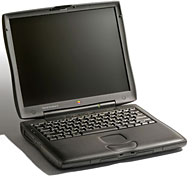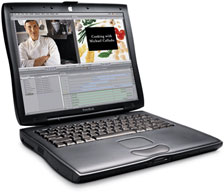In Too Much
Focus Means Too Few Mac Expansion Options, Dan Knight notes that
this week marks the fifth anniversary of the
first 15" MacBook
Pro shipments as well as the 11th anniversary of the unveiling the
last of the expandable Mac notebooks, the Pismo PowerBook.

WallStreet PowerBook
Dan maintains that "as much as we love the Pismo here at Low End
Mac, the WallStreet
PowerBook was even more expandable. And, of course, bigger and
heavier."
Factually, Dan is correct. The WallStreet represented the all-time
high water mark in Apple laptop expandability and versatility, with its
two fully-enabled removable device/battery bays, twin CardBus slots, a
full array of contemporaneous I/O ports including SCSI, S-video, VGA,
and Infrared ports.
However, having owned a WallStreet and three Pismos, I without
hesitation rate the Pismo as being the more desirable machine by a
substantial margin - indeed, it gets my vote as the best Mac laptop
ever.

Pismo PowerBook
The Pismo gets the nod for being almost as easy to open up and work
on as the WallStreet (the hard drive isn't quite as simple to remove,
requiring extraction of four Torx T-8 screws rather then a simple
pull), evidently no less robust notwithstanding its more than a pound
lighter weight and slimmer profile, even more successfully upgradable
to G4 power, able to support OS X on boot volume partitions larger
than 8 GB thanks to its New World ROM, and
more usefully connectable over the long haul than the WallStreet thanks
to having both FireWire and USB ports, which are still I/O standards 11
years on with upgraded speed capability (but still compatible), whereas
the WallStreet represented the second-last gasp for SCSI on Mac laptops
and the last for ADB and DIN-8 serial ports.
This happy combination of expandability and modern I/O connectivity
has made it possible for me to continue using Pismos as production
machines for an amazing 10-plus years and counting, including the one
I'm typing this column on right now. While the Pismo only supports
removable devices in its right-side bay (you can also stick a second
battery in there and with extended life units expand battery runtime to
10-12 hours), that hasn't proved a significant shortcoming, nor has the
50% fewer CardBus slots, thanks to the daisy-chaining versatility and
hot pluggability of USB and FireWire, which are represented by two
ports respectively on the Pismo.
As Dan observes, since the Pismo was discontinued in January 2001,
it's been downhill from there in terms of Mac laptop expansion options
- no device bays, no way to add a second battery, no simple way to swap
out the optical drive, and - aside from RAM and hard drive access in
the unibody MacBooks and MacBook Pros - nothing nearly as easy to tear
down and work on as the Pismo. PC Cards slots were gone after the last
PowerBooks, and Apple has phased out the successor ExpressCard/34 slots
even on its recent 15" MacBook Pro models, although the the far less
flexible and versatile SD Card slot has picked up some of the slack on
some MacBook Pro models. Even batteries have been non-swappable and
only removable via a teardown since the 2009 refreshes.
That said, I love my Late 2008 13" Unibody MacBook,
which for two years has been a flawless and able performer despite its
I/O poverty, and the current crop of MacBooks, MacBook Pros and MacBook
Airs are - in terms of raw performance, looks, price, and general
coolness - the best value Apple has ever offered in its notebooks. I
mean, whoda thunk 11 years ago (when the base Pismo was selling for
$2,499 2000 dollars) that we would ever be able to buy a Mac laptop as
powerful and capable as a MacBook or a 11.6" MacBook Air for less
than a thousand dollars?
However, I wonder if any examples of these machines will still be in
active service in their 11th year the way two of my Pismos still are.




